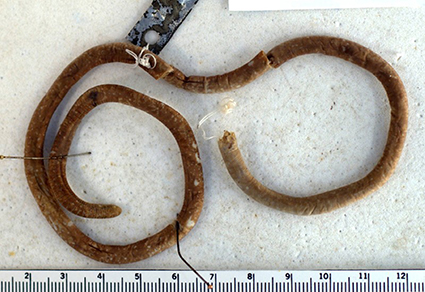Abstract
We here describe a new species of the genus Caecilia from the Pacific lowlands of Colombia that was mistaken in previous literature as C. tenuissima, but which has more primary and secondary grooves than that species (among other differences). The description of Caecilia wilkinsoni sp. nov. restricts the known distribution of C. tenuissima to Guayaquil, Ecuador, re-establishing its status as an endemic species. We comment on the type locality of C. tenuissima, the current condition of its holotype, and on the distributions of the Caecilia that inhabit the Pacific region of Colombia.
References
- Arredondo-Salgar, J.C. (2007) Caecilia thompsoni (Thompson’s Caecilian). Maximum body size. Herpetological Review, 38 (4), 444–445.
- Fernández-Roldán, J.D., Lynch J.D. & Medina-Rangel, G.F. (2023) On the identities of Caecilia degenerata Dunn, 1942 and of C. corpulenta Taylor, 1968 (Amphibia: Gymnophiona: Caeciliidae) with descriptions of three new species of Caecilia Linnaeus, 1758 from the Cordillera Oriental of Colombia. Zootaxa, 5227 (2), 205–228. https://doi.org/10.11646/zootaxa.5227.2.3
- Frost, D. (2021) Amphibian Species of the World: an Online Reference. Version 6.1. American Museum of Natural History, New York, USA. Electronic Database accessible. Available from: https://amphibiansoftheworld.amnh.org/index.php (accessed 7 August 2022) https://doi.org/10.5531/db.vz.0001
- Funk, W.C., Fletcher-Lazo, G., Nogales-Sornosa F. & Almeida-Reinoso, D. (2004) First description of a clutch and nest site for the genus Caecilia (Gymnophiona: Caeciliidae). Herpetological Review, 35 (2), 128–130.
- Lynch, J.D. (2000) Una aproximación a las culebras ciegas de Colombia (Amphibia: Gymnophiona). Revista de la Academia Colombiana de Ciencias Exactas, Físicas y Naturales, 23 (Suplemento Especial), 317–337.
- Lynch, J.D. & Suárez-Mayorga, A.M. (2004) Anfibios en el Chocó Biogeográfico. In: Rangel, J.O. (Ed.), Diversidad Biótica IV: El chocó biogeográfico/Costa Pacífica. Unibiblios, Bogotá, pp. 637–667.
- Pérez, O.D., Lai, N.B., Buckley, D., del Pino, E.M. & Wake, M.H. (2009) The morphology of prehatching embryos of Caecilia orientalis (Amphibia: Gymnophiona: Caeciliidae). Journal of Morphology, 270, 1492–1502. https://doi.org/10.1002/jmor.10772
- Pisso-Flórez, G.A., Silva-Velasco M.A., Maya, A.M., Vanegas, J. & González-Duran, G. (2018) Lista preliminar de los anfibios del Parque Nacional Natural Munchique y áreas de influencia, departamento del Cauca – Colombia. Revista Novedades Colombianas, (2), 49–80.
- Taylor, E.H. (1968) The Caecilians of the World: A Taxonomic Review. University of Kansas Press, Lawrence, Kansas, 848 pp.
- Taylor, E.H. (1973) A Caecilian miscellany. University of Kansas Science Bulletin, 50, 187–231. https://doi.org/10.5962/bhl.part.25759
- Wilkinson, M., San Mauro, D., Sherratt, E. & Gower, D.J. (2011). A nine-family classification of caecilians (Amphibia: Gymnophiona). Zootaxa, 2874 (1), 41–64. https://doi.org/10.11646/zootaxa.2874.1.3


